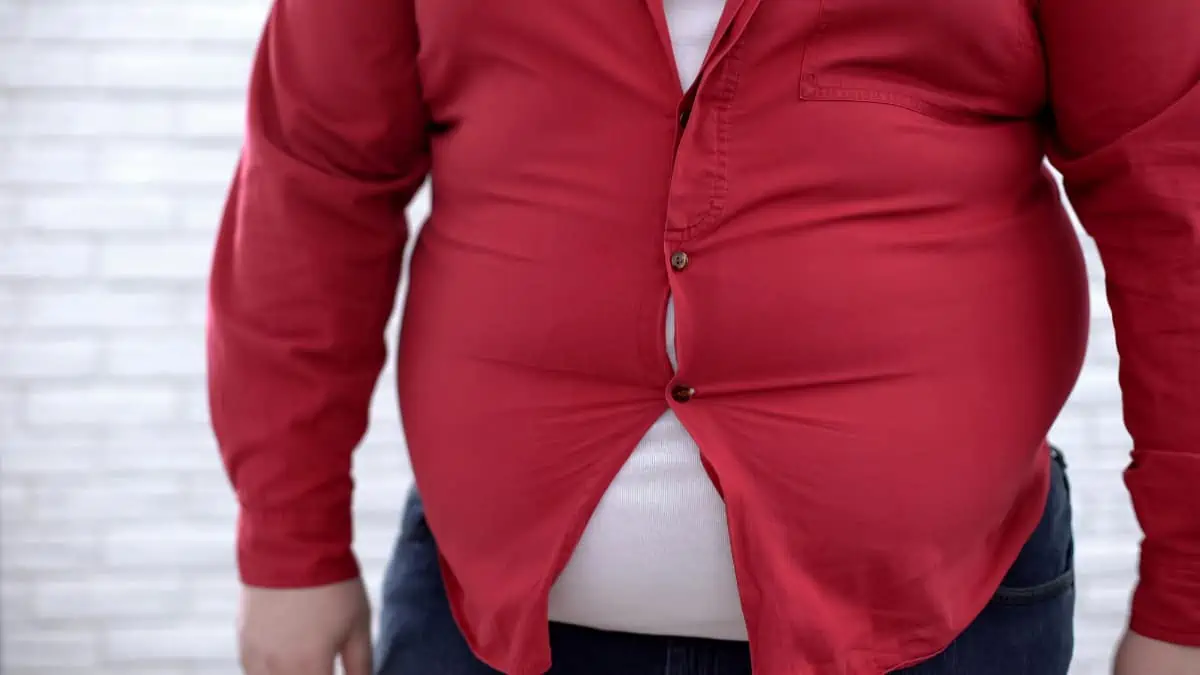A 56 inch waist is far from the ideal waist size for a woman or a man. This is because if you have a 56″ waist, then you’re risking your long-term health and putting a lot of stress on your vital organs.
And yet, it’s completely possible to reduce the size of your 56 in waist if you understand one key piece of information: Successful weight loss requires that your body is in an energy deficit. More on that later.
How big is a 56 inch waist for a female?

According to anthropometric measurement data, a 56 inch waist is 18 inches bigger than average for a woman. Research shows that your overall level of adiposity (basically how much body fat you have) is a strong predictor of all-cause mortality. [1]
So while you shouldn’t feel that you need to look like a model or a workout warrior, you do need to slim your waist significantly if you want to improve your physical health.
This may be even more true for a woman because, as a female, you’re likely to have less lean mass than a man, which means that a higher proportion of your stomach size will consist of fat.
Of course, nobody has a 56 inch waistline of pure muscle; that would be impossible. However, the more of your stomach that consists of fat as opposed to muscle mass, the more abdominal adiposity you have.
How about for a male?

For a man, a 56 inch waist is 16 inches bigger than average and could be especially dangerous to your health if you’re elderly.
Research demonstrates that your waist-to-hip ratio is strongly correlated with mortality, more so than BMI. [2] This shows that the size of your stomach, more so than merely being obese, is a cause for concern in older men.
It’s also widely accepted in the medical community that having an excessively large waist also increases your risk of chronic diseases like diabetes and heart disease.
Yet, having a 56 in waist can also be damaging in the short term. After all, the more weight that you have to carry around, the more stress there is on your joints. As such, it’s best to begin your weight loss journey as soon as possible so that you can walk around and exercise in, at the very least, some level of decent comfort.
Why is having a 56 inch waist so bad for your health?

Most people don’t accumulate a 56 inch waist by eating healthy foods. No, they have a 56″ waist because they overconsume junk foods.
These foods often contain minimal amounts of micronutrients, which is to say, the essential vitamins and minerals that your body needs in order to function.
So besides making you gain weight—which increases the stress that gets placed on your heart—poor food choices can also lead to undernutrition, which can leave you lacking in energy and vitality (in other words, with little motivation to change).
We’ve already explained how having a 56 inch belly primes your body to accept chronic disease.
Yet, if you have such a stomach size, then it’s also likely that you don’t exercise.
Working out at even a low or moderate intensity comes with a variety of health benefits, so you’re definitely missing out if you lead a sedentary lifestyle.
How can you slim your 56 in waist naturally?

You might have heard of the idea that you need to eat in a calorie deficit if you want to lose weight.
This is definitely true, so you can’t blame your metabolism [3] if you don’t lose fat because if you were in a calorie deficit, then your body would have no choice but to decrease in mass.
But in terms of food choices, certain types of food definitely make shedding the pounds easier. Consuming lower-calorie protein sources such as beans, lean meats, and white fish will help your muscles to recover from exercise without creating a major dent in your caloric budget.
Many people recommend avoiding fats, but this is bad advice because fats are necessary to maintain healthy hormone levels. Salmon, nuts, and full-fat dairy (which are all incredibly filling and are also packed with protein) have plenty of nutritious fats and make an excellent addition to any meal.
While eating sugary carb sources can increase your cravings, sticking to starchy carbohydrates like rice and potatoes will fuel your workouts and provide your body with plenty of fiber, which will improve your digestion (as will drinking enough water).
In conclusion

Now that you know the negative effects that having a 56 inch waist can inflict on your physical health, it’s time to begin your stomach slimming journey.
We’ve gone over the basics of calorie manipulation and macro nutrition, and you can find many low-calorie (and yet delicious) recipes in both cookbooks and online.
As for your exercise, walking—a natural, essential, and yet commonly overlooked human activity—is always a great place to start. Aim to get out in the fresh air for a daily walk, as doing so will burn extra calories and improve your digestion and mood.
If you don’t want to go to the gym, then you can improve your fitness with simple home-based workouts. Running on the spot for short bursts of intense sprinting followed by a quick rest is an excellent way to burn fat. Jumping jacks and burpees are similarly effective, and you can pair pretty much any exercises together in a circuit training fashion to get a cardiovascular benefit.
References
- Katzmarzyk, P., Craig, C., & Bouchard, C. (2002). Adiposity, adipose tissue distribution and mortality rates in the Canada Fitness Survey follow-up study. International Journal of Obesity, 26(8), 1054–1059. https://doi.org/10.1038/sj.ijo.0802057
- Kalmijn, S., Curb, J., Rodriguez, B., Yano, K., & Abbott, R. (1999). The association of body weight and anthropometry with mortality in elderly men: The Honolulu Heart Program. International Journal of Obesity, 23(4), 395–402. https://doi.org/10.1038/sj.ijo.0800832
- Hochwald, L. (2021, August 18). How to lose weight in middle age — since you can’t blame metabolism. New York Post. https://nypost.com/2021/08/17/how-to-lose-weight-in-middle-age-without-blaming-metabolism/

